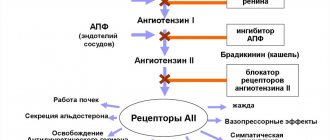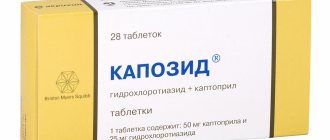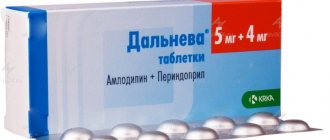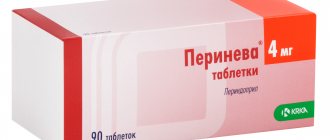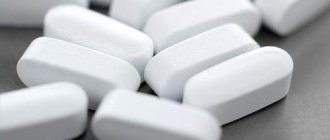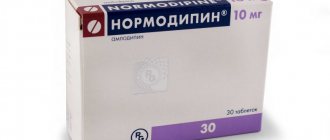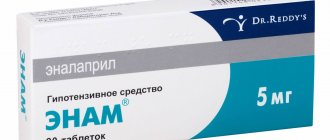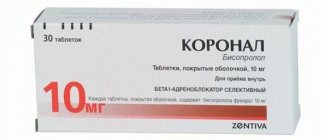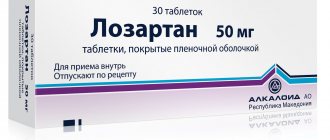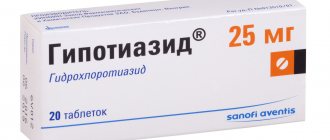Pharmacological properties
Atacand is an antihypertensive drug - an angiotensin II receptor antagonist, selectively acting on AT1 receptors.
Pharmacodynamics
Angiotensin II is a key hormone of the renin-angiotensin-aldosterone system, playing an important role in the pathogenesis of heart failure, arterial hypertension and other diseases of the cardiovascular system. Its main physiological effects include vasoconstriction, stimulation of cell growth, normalization of water-electrolyte homeostasis and stimulation of aldosterone synthesis. All these effects are due to the interaction of angiotensin II with AT1 receptors (angiotensin receptor type 1).
Candesartan belongs to the group of selective antagonists of angiotensin II type 1 receptors (AT1 receptors). This substance is not an inhibitor of the angiotensin-converting enzyme (ACE), which is responsible for the conversion of angiotensin I to angiotensin II and carries out the destruction of bradykinin, and also does not affect ACE and does not cause the accumulation of substance P or bradykinin. A comparison of candesartan with ACE inhibitors showed that in patients taking candesartan cilexetil, cough, which is an adverse reaction, was less common. Candesartan is not characterized by binding to receptors of other hormones and blocking ion channels through which the functions of the cardiovascular system are regulated. Due to the blocking of AT1 receptors of angiotensin II, an increase in renin activity, the content of angiotensin I and angiotensin II, as well as a decrease in the level of aldosterone in the blood plasma are observed. These effects are dose-dependent.
In patients with arterial hypertension, the use of candesartan leads to a dose-dependent decrease in blood pressure, and the effect of Atacand lasts quite a long time. The antihypertensive effect is associated with a decrease in total and peripheral vascular resistance, while heart rate remains unchanged. There are no reports of cases of severe arterial hypotension after the introduction of the first dose of Atacand into the body, as well as the development of o) syndrome after discontinuation of drug therapy. After taking the first dose of candesartan, its antihypertensive effect usually appears within 2 hours. Provided that Atacand therapy is continued in a strictly defined dose, the maximum reduction in blood pressure is usually achieved within 4 weeks and persists throughout the entire course of treatment. When candesartan is prescribed once a day, a gradual and effective decrease in blood pressure is ensured over 24 hours with a slight variation in blood pressure in the intervals between doses of the drug. The combination of candesartan with hydrochlorothiazide enhances the antihypertensive effect. When taken together, candesartan and hydrochlorothiazide (or amlodipine) are well tolerated.
The effectiveness of Atacand is not determined by the gender and age of patients.
Candesartan cilexetil increases renal blood flow, and the glomerular filtration rate increases or remains unchanged, while the filtration fraction and renal vascular resistance decrease. Taking Atacand at a dose of 8-16 mg for 12 weeks does not have a negative effect on the lipid profile and glucose levels in patients with type 2 diabetes mellitus and arterial hypertension. The clinical effect of the active substance Atacanda on morbidity and mortality when taking the drug at a dosage of 8-16 mg (average 12 mg) once a day was studied in a randomized clinical trial that involved 4937 elderly patients (age 70-89 years, 21% of participants were aged 80 years or older), had mild to moderate hypertension, and were treated with candesartan for an average of 3.7 years [studied as part of the SCOPE study. functions in elderly patients)]. Patients took placebo or candesartan cilexetil, supplemented, if necessary, with other antihypertensive drugs. With both treatment regimens, an effective reduction in diastolic and systolic blood pressure was found (from 167/90 to 149/82 mm Hg in the control group of participants and from 166/90 to 145/80 mm Hg in the group of patients taking Atacand), and the drug was well tolerated. Quality of life and cognitive function remained at the proper level in both groups of experiment participants. There were no statistically significant differences in the incidence of cardiovascular complications (incidence of non-fatal stroke and myocardial infarction, cardiovascular mortality) between these two groups.
There were 26.7 cardiovascular events per 1000 patient-years in the candesartan group compared with 30 per 1000 patient-years in the placebo group (p = 0.19, 95% confidence interval (CI) – 0.75‒1.06, relative risk – 0.89).
The results of the assessment of the primary endpoint (complications from the cardiovascular system) and its components are as follows:
- occurrence of cardiovascular events: in 242 patients with a primary event receiving candesartan cilexetil (N = 2477) and 268 patients in the control group (N = 2460), the relative risk (95% CI) was 0.89 (range 0.75 - 1.06), p = 0.19;
- Cardiovascular mortality: In 145 patients with a primary event receiving candesartan cilexetil (N = 2477) and 152 control patients (N = 2460), the relative risk (95% CI) was 0.95 (range 0.75 - 1 .19), p = 0.63;
- non-fatal myocardial infarction: in 54 patients with a primary event receiving candesartan cilexetil (N = 2477) and 47 control patients (N = 2460), the relative risk (95% CI) was 1.14 (range 0.77-1. 68), p = 0.52;
- Nonfatal stroke: In 68 patients with a primary event receiving candesartan cilexetil (N = 2477) and 93 control patients (N = 2460), the relative risk (95% CI) was 0.72 (range 0.53‒0.99) ), p = 0.04.
Before randomization, any previous antihypertensive drug therapy was standardized to hydrochlorothiazide administered at a dosage of 12.5 mg once daily. Another antihypertensive drug was added to the double-blind study drug (placebo or candesartan cilexetil 8–16 mg once daily) if systolic blood pressure was equal to or greater than 160 mmHg. Art. and/or diastolic blood pressure was equal to or greater than 90 mm Hg. Art. Such additional treatment was received by 66% and 49% of patients in the control group and the candesartan cilexetil group, respectively.
Results from the CHARM trial, which assessed the reduction in mortality and morbidity with candesartan in patients with chronic heart failure, showed that Atacand resulted in a reduction in the incidence of death and the need for hospitalization associated with exacerbation of chronic heart failure, as well as normalization of left ventricular systolic function.
As an addition to the main therapy, patients with chronic heart failure took candesartan cilexetil at a daily dose of 4–8 mg, increasing the dose to 32 mg per day or to the maximum tolerated therapeutic dose (the average dose of the drug was 24 mg). The median follow-up duration was 37.7 months. After six months of treatment, 63% of patients who continued to take Atacand (89% of the total) received a therapeutic dose of 32 mg.
The other CHARM-Alternative study (n = 2028) included patients with a reduced left ventricular ejection fraction (LVEF) of 40% or less who were unable to take an ACE inhibitor due to intolerance (primarily cough, 72%). The incidence of first hospitalization associated with chronic heart failure and deaths due to cardiovascular diseases were significantly lower in the group of patients taking candesartan compared with the placebo group (confidence interval was 0.67‒0.89, p not exceeded 0.001, the risk ratio was 0.77). At the same time, the relative risk decreased by 23%. In this study, according to statistical requirements, to prevent 1 case of death due to cardiovascular complications or hospitalization for chronic heart failure, treatment of 14 patients was required during the entire study period. In the group of patients taking candesartan, the combined indicator, which includes the rate of first hospitalization due to chronic heart failure (CHF), and the incidence of deaths, regardless of their causes, was also significantly lower (95% confidence interval, ranging from 0.7 to 0 .92, risk ratio is 0.8, p = 0.001). At the same time, a positive effect of the active substance Atacanda on each of the components of this combined criterion was observed: morbidity (an indicator of the frequency of admission to hospital associated with CHF) and the frequency of deaths. The result of taking candesartan cilexetil was an improvement in the functional class of CHF in accordance with the NYHA classification (p equal to 0.008).
In patients with reduced LVEF (equal to or less than 40%) who were taking ACE inhibitors, the CHARM-Added study (n = 2548) found that a composite measure of first CHF hospitalization and mortality caused by cardiovascular disease was significantly lower in the group of patients receiving candesartan compared with the group of patients receiving placebo (95% confidence interval, 0.75 to 0.96, risk ratio 0.85, p = 0.011), which corresponds to a 15% reduction in relative risk. In this experiment, to prevent 1 case of hospitalization for CHF or death caused by cardiovascular complications, it was necessary to treat 23 patients during the entire study period. The value of the combined effectiveness indicator, which includes an assessment of the frequency of first hospitalization for CHF and the frequency of deaths, regardless of their causes, was significantly lower in the group of patients taking Atacand (95% confidence interval, ranging from 0.78 to 0. 98, risk ratio equal to 0.87, p = 0.021), which confirms the positive effect of treatment with candesartan. The use of the drug contributed to the improvement of the functional class of CHF according to the NYHA classification (p equal to 0.02).
The CHARM-Preserve study was conducted in patients with preserved systolic function (LVEF greater than 40%) (n = 3023). During its course, in the groups of patients receiving placebo and candesartan, no statistically significant differences were found in the value of the combined effectiveness indicator, including the frequency of the first hospitalization due to CHF and the frequency of deaths (95% confidence interval, ranging from 0.77 to 1 .03, risk ratio is 0.89, p = 0.118). A small numerical decrease in this criterion is explained by a decrease in the frequency of hospital admissions for CHF. This study did not examine the effect of Atacand on mortality.
When the results of three studies conducted as part of the CHARM program were analyzed separately, there were no statistically significant differences in the incidence of deaths in the groups of patients taking placebo and candesartan. However, this was assessed in the pooled population of the CHARM-Added and CHARM-Alternative studies and in all three studies (95% confidence interval 0.83 to 1, hazard ratio 0.91, p = 0.055). The reduction in the incidence of hospitalization for CHF and the incidence of deaths while taking candesartan was not determined by gender, age and concomitant treatment. The effectiveness of the drug has also been proven in patients taking ACE inhibitors in combination with beta-blockers, and it did not depend on whether the patient was taking an ACE inhibitor at the optimal dose or not.
In patients with reduced left ventricular systolic function (LVEF equal to or less than 40%) and CHF, the use of candesartan provided a decrease in capillary pressure in the lungs and total peripheral vascular resistance, a decrease in the concentration of aldosterone, as well as an increase in the content of angiotensin II in the blood plasma and renin activity.
Pharmacokinetics
Candesartan cilexetil is an oral prodrug. After ingestion, it is rapidly biotransformed into candesartan by ether hydrolysis upon absorption from the gastrointestinal tract. The substance does not have agonist properties, dissociates slowly and reliably binds to AT1 receptors. The estimated absolute bioavailability is 14%. The maximum level of candesartan in the blood serum is usually recorded 3-4 hours after taking the tablets. As the dose of Atacand increases within the range of recommended doses, a linear increase in the concentration of the active substance is observed. The pharmacokinetic parameters of candesartan are not determined by the gender of the patient. Food intake does not have a clinically significant effect on AUC (area under the concentration-time curve), therefore, when taking the drug with food, its bioavailability does not change significantly. The degree of binding of candesartan to plasma proteins is quite high and exceeds 99%, and the volume of distribution is 0.1 l/kg.
The drug is predominantly excreted unchanged from the body with bile and urine and only to a small extent participates in the processes of hepatic metabolism. Its half-life is about 9 hours, and there is no accumulation in the body.
The total clearance of the drug is approximately 0.37 ml/min/kg, and the renal clearance is approximately 0.19 ml/min/kg. Renal excretion of candesartan occurs by active tubular secretion and glomerular filtration. When taking radiolabeled candesartan cilexetil orally, approximately 26% of the dose taken is excreted unchanged through the kidneys and 7% as a pharmacologically inactive metabolite. At the same time, 56% of the dose taken is excreted in feces in the form of unchanged candesartan, and 10% in the form of an inactive metabolite.
In elderly patients (over 65 years), the AUC and maximum concentration of the active substance increase by 80% and 50%, respectively, compared to younger patients. However, the incidence of side effects and the hypotensive effect when taking Atacand are not determined by the age of the patients.
In patients with mild to moderate renal dysfunction, the AUC and maximum concentration of candesartan increased by 70% and 50%, respectively, but the half-life remained unchanged compared with patients with normal renal function. In patients with severe renal impairment, the AUC and maximum concentration of the drug increased by 110% and 50%, respectively, and the half-life increased by 2 times. In patients undergoing hemodialysis, the pharmacokinetic parameters of candesartan are the same as in patients with severe renal dysfunction.
In patients with mild to moderate liver dysfunction, the AUC of candesartan increases by 23%.
Pharmacokinetics
Atacand is a prodrug intended for internal use. Candesartan is quickly transformed into the active component by ether hydrolysis. When absorbed from the stomach, the substance interacts with AT1 receptors and gradually dissociates without exerting agonist properties.
Bioavailability of Atacand after oral administration is 14–34%. The optimal content of the main component in the blood (Cmax) is observed 3–4 hours after taking the tablet.
With increasing dosage, candesartan levels increase linearly. Eating food does not particularly affect the AUC (pharmacokinetic curve of candesartan after a single dose).
Atacand interacts with plasma proteins by 99%. The volume of distribution of the drug is 0.1 l/kg.
Candesartan is excreted through the kidneys and bile. The substance is excreted in unchanged form. Only a small part of the component undergoes biotransformation in the liver.
The half-life is 9 hours. Candesartan does not accumulate in tissues.
Total clearance – 0.37 ml/min/kg, renal clearance – 0.19 ml/min/kg. Renal excretion is accomplished by tubular secretion and ultrafiltration.
In patients over 65 years of age, AUC and Cmax increase by 50 and 80%. But the frequency of occurrence of negative effects and hypotensive effects does not depend on age characteristics.
In patients with mild to moderate renal dysfunction, AUC and Cmax increase by 70 and 50%, and the half-life (T1/2) does not change, compared with healthy people who do not have impaired renal function.
In severe renal dysfunction and in patients on hemodialysis, AUC and Cmax increase by 110 and 50%, and T1/2 increases by 2 times. In patients with liver dysfunction, an increase in AUC of 23% was recorded.
Contraindications
- Liver dysfunction or cholestasis;
- Hypersensitivity to the active substance or other components of Atacand;
- Pregnancy and lactation period.
This medicine should be taken with caution:
- Severe renal failure;
- Bilateral renal artery stenosis;
- Cerebrovascular diseases and coronary heart disease;
- History of kidney transplant;
- Age up to 18 years.
Atacanda price
| Names of capital's pharmacies | Price of tablets 8 mg, No. 28, rubles |
| Online pharmacy "Dialogue" | 1 900 |
| Internet pharmacy "Yug" | 2 045 |
| NIKA | 2 150 |
| Evalar | 2 200 |
| Beauty and health laboratory | 2 200 |
| Doctor Stoletov | 2 250 |
| Pharmapark | 2 350 |
| ElixirPharm | 2 400 |
| Samson-Pharma | 2 400 |
| EuroPharm | 2 400 |
Instructions for use Atakanda: method and dosage
Atacand tablets are taken regardless of meals once a day.
For arterial hypertension, the initial and maintenance dose, regardless of age, is 8 mg per day, in some cases - 16 mg. If the therapy does not lead to a decrease in blood pressure, combined use of Atacand with a thiazide diuretic is recommended. Mild and moderate renal dysfunction does not require dose adjustment. For mild to moderate liver dysfunction, the initial dose should not exceed 2 mg per day. The maximum antihypertensive effect during treatment with the drug is achieved within a month from the start of treatment.
For heart failure, Atacand should be taken 4 mg per day at the beginning of treatment, subsequently the dose can be doubled every two weeks (up to 32 mg per day). Atacand is effective when used simultaneously with other drugs for chronic heart failure - beta-blockers, ACE inhibitors, cardiac glycosides and diuretics.
Elderly patients and patients with impaired renal function do not require adjustment of the initial dose of the drug.
Brief information about the drug
The antihypertensive drug Atacand has a second international name: Candesartan. The drug belongs to the angiotensin-2 receptor blockers or sartans. The medication suppresses the active effect of the hormone, dilating the walls of blood vessels and normalizing blood pressure.
Release form and packaging
The drug Atacand is available in tablet form. There are tablets on sale with different contents of the active component candesartan cilexetil: 8, 16, 32 mg.
The white tablet with a dividing line allows you to choose the desired dosage.
Each tablet is packaged in an individual blister cell. Each package contains 28 tablets. The amount of active ingredient in milligrams is indicated on the package. The kit includes instructions for using Atakanda.
Packaging Atacanda
Compound
The main active ingredient of Atacand tablets is candesartan cilexetil.
Other components included in the drug:
- hydrolase;
- calcium salts;
- carmellose;
- iron oxide;
- lactose;
- potato starch;
- magnesium salts;
- polyethylene glycol.
Price and terms of sale
Atacand blood pressure tablets are sold in pharmacies with a prescription from your doctor. The medicine is available only in tablet form. The price of Atakand depends on the amount of the main component in the composition, packaging, manufacturer and starts from 1,500 rubles.
Storage conditions
The blood pressure medication Atacand must be stored out of the reach of children at a temperature not exceeding 30 degrees.
The shelf life of the drug is 3 years from the date of manufacture. After the expiration date, the drug cannot be used. It must be disposed of in accordance with sanitary standards.
Side effects
Atacand is usually well tolerated.
Side effects that occur when taking the drug do not depend on age and dose taken.
When treating arterial hypertension, weakness, dizziness, respiratory infections, headache, and back pain most often develop.
In the complex treatment of chronic heart failure, Atacand can cause: a marked decrease in blood pressure, leukopenia, neutropenia, agranulocytosis, impaired renal function, angioedema, hyperkalemia, hyponatremia, arthralgia, nausea, weakness, dizziness, headache, myalgia, back pain, urticaria , skin itching, rash.
Side effects of the drug Atacand
For the treatment of arterial hypertension (HTN) During controlled clinical trials, side effects were mild, temporary and comparable to placebo. The overall incidence of side effects did not appear to be dose or age related. The rate of treatment discontinuation due to adverse reactions was similar for candesartan cilexetil (3.1%) and placebo (3.2%). The following common (1/100) adverse reactions were reported (the incidence of side effects that was at least 1% higher than the incidence of such effects when using placebo): from the nervous system: dizziness, headache. infections and infestations: respiratory tract infections. Results of laboratory studies No clinically significant effect of Atacand on laboratory parameters was noted. When using other inhibitors of the renin-angiotensin-aldosterone system, a slight decrease in hemoglobin was detected. Creatinine, urea, or potassium levels increased and sodium levels decreased. Increases in ALT, considered an adverse event, were not significantly more frequently reported with Atacand than with placebo (1.3 vs. 0.5%). For patients receiving Atacand, continuous monitoring of laboratory parameters is not necessary. However, periodic monitoring of serum potassium and creatinine levels is recommended in patients with renal impairment. For heart failure: the side effect profile of Atacanda in patients with heart failure is consistent with the pharmacological properties of this drug and the health status of the patients. Common adverse reactions (≥1/100, ≤1/10) identified during clinical trials included: From the cardiovascular system: arterial hypotension. Metabolic and nutritional disorders: hyperkalemia. From the urinary system: renal failure. Laboratory test indicators: increased levels of creatinine, urea and potassium. Periodic monitoring of serum creatinine and potassium levels is recommended. Post-marketing study: the following side effects were reported very rarely (≤1/10,000): from the blood system: leukopenia, neutropenia and agranulocytosis; metabolic and nutritional disorders: hyperkalemia, hyponatremia; from the nervous system: dizziness, headache; from the gastrointestinal tract: nausea; from the hepatobiliary system: increased levels of liver enzymes, abnormal liver function or hepatitis; from the skin and subcutaneous tissue: angioedema, rash, urticaria, itching; from the musculoskeletal system, connective tissue: back pain, arthralgia, myalgia; from the urinary system: impaired renal function, including renal failure in predisposed patients.
Overdose
According to the results of the analysis of pharmacological data regarding Atacand, the main symptoms of overdose are presumably dizziness and a clinically significant decrease in blood pressure. There are reports of isolated cases of drug overdose (the dose did not exceed 672 mg of candesartan cilexetil), which resulted in the recovery of patients without severe complications.
If there is a clinically significant decrease in blood pressure, symptomatic therapy should be prescribed and the patient’s condition should be constantly monitored, and the patient should be placed on his back with his legs secured in an elevated position. If necessary, it is recommended to increase the volume of circulating blood plasma, for example, through intravenous administration of 0.9% sodium chloride solution. In some cases, sympathomimetic drugs are prescribed. Candesartan is unlikely to be eliminated by hemodialysis.
Overdose of the drug Atacand, symptoms and treatment
Symptoms: hypotension and dizziness. Information on an individual case of overdose (up to 672 mg of candesartan cilexetil) reported that the patient recovered without consequences. Treatment: symptomatic, monitoring vital functions. The patient should be placed on his back with his lower limbs elevated. If this is not enough, it is necessary to increase the volume of blood plasma by infusion, for example, an isotonic saline solution. Candesartan is not eliminated by hemodialysis.
special instructions
Atacand may negatively affect kidney function. In case of renal failure, their performance indicators should be regularly monitored. Such control is also necessary in the treatment of myocardial failure.
Calibration of therapeutic doses is mandatory in case of weakened myocardial function in patients with kidney pathologies (with elevated levels of calcium in the blood, and in combination with ACE inhibitors), since in such cases, taking Atacand increases the risk of complications.
The use of Atacand can cause stenosis of the renal artery, hypotension (in case of myocardial insufficiency), and hypovolemia.
If surgery and the use of anesthetics are planned while taking Atacand, the risk of hypotension should be taken into account.
When a daily dose of 32 mg does not give the desired effect, the decision on the further advisability of using the drug must be made by the attending physician.
Patients with hyperaldosteronism are not prescribed tablets, since therapy with this group of drugs is not effective.
Atacand should be discontinued immediately after pregnancy is diagnosed.
Impact on the ability to drive vehicles and complex mechanisms
Atacand does not affect the ability to drive a car or operate complex machinery, but it should be remembered that possible side effects may occur in the form of weakness, increased fatigue and dizziness.
Pharmacodynamic properties - how they affect blood pressure
The body produces the hormone angiotensin 2, which controls cellular development and water-salt metabolism. When a person’s life is threatened due to heavy blood loss or low blood glucose, the hormone narrows the walls of blood vessels.
If disturbances occur in the production of the hormone, the vessels are constantly in an expanded or narrowed state, which leads to an increase or decrease in blood pressure.
Atacand blocks active angiotensin 2 receptors selectively, which leads to a mild decrease in blood pressure. The drug Atacand for blood pressure rarely leads to the development of adverse reactions, so it is in first place among doctors as prescribed for hypertension.
Mechanism of action of Atakanda at high blood pressure:
- the drug activates angiotensinogenase, which narrows the walls of blood vessels with the help of the hormone angiotensin 2;
- angiotensin 2 lowers aldosterone levels;
- aldosterone is produced less and does not lead to increased blood pressure;
- the pressure gradually decreases to normal levels.
Mechanism of action of angiotensin II receptor blockers
Use during pregnancy and lactation
According to the instructions, Atacand is contraindicated for pregnant women. Patients receiving this drug should be informed about this before planning pregnancy, which will allow them to discuss alternative treatment options with a specialist. In case of confirmed conception, the drug is immediately discontinued and, if necessary, alternative therapy is prescribed.
Drugs that directly affect the renin-angiotensin-aldosterone system can provoke developmental disorders of the fetus (slow ossification of the skull bones, oligohydramnios, renal dysfunction) or negatively affect the newborn (development of hyperkalemia, arterial hypotension, renal failure), even death, if Atacand was continued during pregnancy.
To date, it remains unknown whether candesartan passes into breast milk. Due to possible adverse effects on infants, Atacand is not recommended for use during lactation.
Drug interactions
Taking Atacand in combination with drugs that contain aliskiren is contraindicated in patients with moderate or severe renal failure (glomerular filtration rate less than 60 ml/min/1.73 m2) or type 1 or 2 diabetes mellitus. It is also not recommended for other patients.
The bioavailability of candesartan is not determined by food intake.
The combination of Atacand and nonsteroidal anti-inflammatory drugs (NSAIDs) may increase the risk of developing renal dysfunction (including increased serum potassium concentrations and acute renal failure), especially in patients with reduced renal function. Caution must be exercised when using these drugs together, especially in patients with reduced circulating blood volume and elderly patients. Such patients require compensation for fluid loss and regular monitoring of renal function after the start of combination treatment and periodically during it.
The combination of NSAIDs (including selective cyclooxygenase-2 inhibitors) and angiotensin II receptor antagonists sometimes leads to a weakening of the hypotensive effect.
In pharmacokinetic studies, the combined use of Atacand with enalapril, hydrochlorothiazide, nifedipine, warfarin, glibenclamide, oral contraceptives (ethinyl estradiol/levonorgestrel), digoxin was studied - no clinically significant pharmacokinetic interaction was found.
Experience with other drugs acting on the renin-angiotensin-aldosterone system suggests that concomitant treatment with potassium-containing salt substitutes, potassium supplements, potassium-sparing diuretics and other drugs that can increase serum potassium concentrations (for example, heparin) may provoke the development of hyperkalemia.
There are reports that the combined use of ACE inhibitors with lithium preparations leads to a reversible increase in serum lithium levels and various toxic effects. Such reactions can also be observed when taking angiotensin II receptor antagonists, so it is necessary to constantly monitor the concentration of lithium in the blood serum when using these drugs in combination.
Candesartan is involved in metabolic processes in the liver, carried out with the participation of the CYP2C9 isoenzyme, to a small extent. As a result of the interaction studies, no effect of the drug on the CYP3A4 and CYP2C9 isoenzymes was revealed, and there is practically no information on interaction with other isoenzymes of the cytochrome P450 system. The combination of Atacand with other antihypertensive drugs enhances the antihypertensive effect.
Compatibility with other drugs
No interactions of clinical significance were found. During the studies, pharmacists studied the interaction of Atacand with Enalapril, oral contraceptives, Hydrochlorothiazide, Nifedipine, Warfarin, Glibenclamide, Digoxin.
Candesartan is excreted in small amounts via metabolism occurring in the liver (CYP 2C9). There was no effect on CYP 3A4 and CYP 2C9. The effect on other cytochrome P450 isoenzymes is little known.
Interaction of Atakand with other means:
- The antihypertensive effect can be enhanced by other drugs that lower blood pressure.
- The combined use of candesartan with potassium-containing drugs (diuretics, supplements, salt substitutes) helps to increase the concentration of the microelement in the blood.
- When taken simultaneously with NSAIDs, the antihypertensive effect of candesartan is reduced.
- Combined use with NSAIDs can worsen kidney function, cause acute liver failure, and hyperkalemia. This is especially true for elderly patients and those whose kidney function is already impaired.
- Concomitant use with Heparin increases the likelihood of hyperkalemia.
- Concomitant use with Aliskiren for diabetes mellitus or severe renal dysfunction is contraindicated.
There is evidence regarding a reverse increase in lithium content in the blood and the toxicity of the substance when lithium is used in parallel with ACE inhibitors. A similar effect may occur with Atacand, which requires monitoring lithium levels in the blood during treatment.
It is not recommended to drink alcohol during the entire period of treatment with candesartan.
